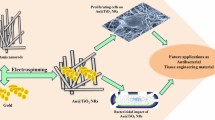Abstract
The main goal of present study was to check interaction of Ag-SiO2 core shell nanoparticles (CSNs) with C2C12 cells. We herein account the synthesis and classification of novel CSNs. We aimed the preparation of CSNs in order to check their biocompatible/cytotoxic impact on C2C12 muscle cells. We aimed to check the CSNs related hazards to human health. The utilized CSNs were synthesized by the straightforward sol–gel method utilizing silver nitrate and tetraethoxysilane as fundamental components. The physicochemical characterization of the CSNs was conceded by means of X-ray diffraction, UV-Vis and transmission electron microscopy. To examine in vitro biocompatibility/cytotoxicity, C2C12 cells were cultured under in vitro environment and afterward subjected to different concentrations of CSNs. The survival of C2C12 cells was evaluated via cell counting Kit-8 assay at exact point gap. These results were authenticated by confocal microscopy. The morphology of C2C12 cells was observed with the help of a phase contrast microscope. In vitro investigation of biological effects of CSNs has revealed that feasibility of cells in culture follows dose (0–20 μg/mL) mode. Overall, results of this investigation demonstrate that synthetic CSNs influence C2C12 cell practicability with time point as well as absorption dependent mode.




Similar content being viewed by others
REFERENCES
Carlson, C., Hussain, S.M., Schrand, A.M., Braydich-Stolle, K.L., Hess, K.L., Jones, R.L., and Schlager, J.J., Unique cellular interaction of silver nanoparticles: size-dependent generation of reactive oxygen species, J. Phys. Chem. B, 2008, vol. 112, no. 43, pp. 13608–13619.
Caruso, F., Nanoengineering of particle surfaces, Adv. Mater., 2001, vol. 13, no. 1, pp. 11–22.
Chen, X. and Schluesener, H., Nanosilver: a nanoproduct in medical application, Toxicol. Lett., 2008, vol. 176, no. 1, pp. 1–12.
Dong, R., Ma, P.X., and Guo, B., Conductive biomaterials for muscle tissue engineering, Biomaterials, 2019, p. 119584.
Edwards-Jones, V., The benefits of silver in hygiene, personal care and healthcare, Lett. Appl. Microbiol., 2009, vol. 49, no. 2, pp. 147–152.
Feng, X., Mao, C., Yang, G., Hou, W., and Zhu, J.-J., Polyaniline/Au composite hollow spheres: synthesis, characterization, and application to the detection of dopamine, Langmuir, 2006, vol. 22, no. 9, pp. 4384–4389.
Garmanchuk, L., Borovaya, M., Nehelia, A., Inomistova, M., Khranovska, N., Tolstanova, G., Blume, Y.B., and Yemets, A., CdS quantum dots obtained by “green” synthesis: comparative analysis of toxicity and effects on the proliferative and adhesive activity of human cells, Cytol. Genet., 2019, vol. 53, no. 2, pp. 132–142.
Ge, L., Li, Q., Wang, M., Ouyang, J., Li, X., and Xing, M.M., Nanosilver particles in medical applications: synthesis, performance, and toxicity, Int. J. Nanomed., 2014, vol. 9, p. 2399.
Gliga, A.R., Skoglund, S., Wallinder, I.O., Fadeel, B., and Karlsson, H.L., Size-dependent cytotoxicity of silver nanoparticles in human lung cells: the role of cellular uptake, agglomeration and Ag release, Part. Fibre Toxicol., 2014, vol. 11, no. 1, p. 11.
Guo, D., Wu, C., Jiang, H., Li, Q., Wang, X., and Chen, B., Synergistic cytotoxic effect of different sized ZnO nanoparticles and daunorubicin against leukemia cancer cells under UV irradiation, J. Photochem. Photobiol., B: Biol., 2008, vol. 93, no. 3, pp. 119–126.
Ko, E.H., Yoon, Y., Park, J.H., Yang, S.H., Hong, D., Lee, K.B., Shon, H.K., Lee, T.G., and Choi, I.S., Bioinspired, cytocompatible mineralization of silica–titania composites: thermoprotective nanoshell formation for individual Chlorella cells, Angew. Chem., Int. Ed., 2013, vol. 52, no. 47, pp. 12279–12282.
Li, X., Wan, M., Wei, Y., Shen, J., and Chen, Z., Electromagnetic functionalized and core-shell micro/nanostructured polypyrrole composites, J. Phys. Chem. B, 2006, vol. 110, no. 30, pp. 14623–14626.
Marambio-Jones, C. and Hoek, E.M., A review of the antibacterial effects of silver nanomaterials and potential implications for human health and the environment, J. Nanopart. Res., 2010, vol. 12, no. 5, pp. 1531–1551.
Reddy, K.M., Feris, K., Bell, J., Wingett, D.G., Hanley, C., and Punnoose, A., Selective toxicity of zinc oxide nanoparticles to prokaryotic and eukaryotic systems, Appl. Physic. Lett., 2007, vol. 90, no. 21, p. 213902.
Roca, M. and Haes, A.J., Silica−void−gold nanoparticles: temporally stable surface-enhanced Raman scattering substrates, J. Am. Chem. Soc., 2008, vol. 130, no. 43, pp. 14273–14279.
Salgueiriño-Maceira, V., Correa-Duarte, M.A., Spasova, M., Liz-Marzán, L.M., and Farle, M., Composite silica spheres with magnetic and luminescent functionalities, Adv. Funct. Mater., 2006, vol. 16, no. 4, pp. 509–514.
Stöber, W., Fink, A., and Bohn, E., Controlled growth of monodisperse silica spheres in the micron size range, J. Colloid Interface Sci., 1968¸ vol. 26, no. 1, pp. 62–69.
Vrček, I.V., Žuntar, I., Petlevski, R., Pavičić, I., Dutour Sikirić, M., Ćurlin, M., and Goessler, W., Comparison of in vitro toxicity of silver ions and silver nanoparticles on human hepatoma cells, Environ. Toxicol., 2014.
Yi, D.K., Lee, S.S., and Ying, J.Y., Synthesis and applications of magnetic nanocomposite catalysts, Chem. Mater., 2006, vol. 18, no. 10, pp. 2459–2461.
Zhao, X., Dong, R., Guo, B., and Ma, P.X., Dopamine-incorporated dual bioactive electroactive shape memory polyurethane elastomers with physiological shape recovery temperature, high stretchability, and enhanced C2C12 myogenic differentiation, ACS Appl. Mater. Interfaces, 2017, vol. 9, no. 35, pp. 29595–29611.
Funding
This research received no Research grant from any funding agency.
Author information
Authors and Affiliations
Corresponding authors
Ethics declarations
The authors declare that they have no conflict of interest. This article does not contain any studies involving animals or human participants performed by any of the authors.
About this article
Cite this article
Touseef Amna, Alghamdi, A.A., Khan, R. et al. Study on Effects of Ag-SiO2 Core Shell Nanoparticles on Biocompatibility Appraisal of Myoblasts. Cytol. Genet. 55, 199–204 (2021). https://doi.org/10.3103/S009545272102002X
Received:
Revised:
Accepted:
Published:
Issue Date:
DOI: https://doi.org/10.3103/S009545272102002X




